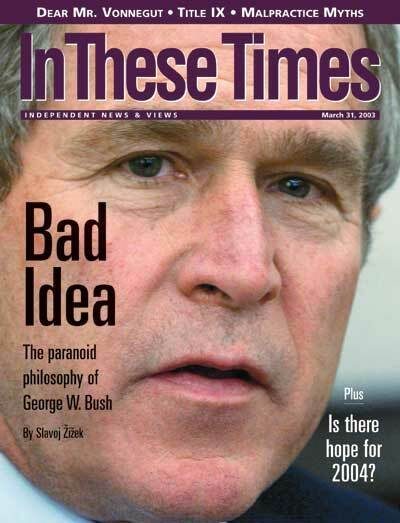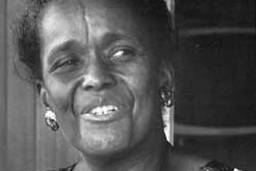
Freedom Dreams marks a significant intellectual turning point for Robin D. G. Kelley—“a kind of crossroads.” In the opening pages, he expresses his alienation from “the same old protest politics.” His stated purpose in Freedom Dreams is to recover the visions of social transformation advanced by black radical movements.
For a born-again Kelley, the path to liberation will not be found in the dog-eared pages of the organizer’s manual, but rather in the apocalyptic visions of revolution touted by the black power era, Revolutionary Action Movement, the poetry of Ted Joans, the literature of Martinican anti-colonial activists Suzanne and Aimé Césaire and the surrealist, Afro-Cuban paintings of Wilfredo Lam. Kelley writes: “Without new visions we don’t know what to build, only what to knock down. We not only end up confused, rudderless, and cynical but we forget that making revolution is not a series of clever maneuvers and tactics but a process that can and must transform us.” Again and again in his heartfelt introduction, he urges the need to refocus on the imagination.
Over the past decade, Kelley has established himself as one of the most well-known and widely read black historians. Against the grain of pedestrian accounts of black history fixated on charismatic elites, Kelley’s intellectual focus on the black working class is refreshing. His precocious debut Hammer and Hoe (1990) narrated the neglected history of black communists in Jim Crow-era Alabama. His subsequent essay collections, Race Rebels (1994) and Yo’ Mama’s Disfunktional! (1997), offered wide-ranging, perceptive critiques of popular misconceptions of black working-class culture.
Yo’ Mama’s Disfunktional! took direct aim at the underclass myth, self-help ideology and their implications for American social provision. Its straw man criticisms of the “enlightenment left” notwithstanding, Yo’ Mama was an important intervention into the post-welfare public debate presented in an accessible language and engaging style. Like the works of Linda Faye Williams, Michael Katz, Adolph Reed Jr., Barbara Ehrenreich and Stephen Steinberg, among others, Yo’ Mama exorcises the neoconservative demonization of the urban poor. Freedom Dreams breaks with that style of political engagement, however.
————–
Readers of his latest book will be rewarded by Kelley’s discussion of the cross-fertilization of revolutionary ideals over the Atlantic, from Caribbean anti-colonial struggles to the metropolitan art circles of mid-20th- century Paris. Kelley’s celebration of “the marvelous” is not new; intellectuals from Andre Bréton to Herbert Marcuse have championed the liberatory power of the imagination. But the political implications of Kelley’s intellectual epiphany are problematic.
By focusing primarily on political ideals, he sidesteps the troublesome issues of strategy and political practice. This interpretative bias is a logical extension of the tendency within neo-Gramscian cultural studies to assign equal weight to the expressive and material dimensions of politics. Hence, the daily acts of resistance on Southern plantations, wearing Zoot suits or cornrow hairstyles and the improvisational genius of John Coltrane or the Roots are seen as comparable to—and for some, more significant than—purposive political actions like staging a union drive, canvassing neighborhoods during an election or demonstrating in front of city hall to protest pending budget cuts. While I certainly do not wish to downplay the importance of consciousness or everyday forms of resistance, cultural opposition is no surrogate for direct political engagement.
Yet Kelley’s opening act of contrition shuns the task of organizing—of effectively combining radical vision with creative modes of political mobilization. This dismissive posture toward hard politics is unsettling. Kelley sees searching for the sources of movement failure as an unproductive venture. Curiously, he concludes that all historical radical movements were essentially failures, “because the basic power relations they sought to change remained pretty much intact.” Perhaps part of Kelley’s disenchantment with organizing stems from this overly cynical view of power and political change.
This fatalistic view of politics is partially descended from ’60s radicalism. Angst over the threat of co-optation within the ranks of black power radicals and the wider New Left led to an anti-statist orientation and, eventually, down various avenues of disengagement. Under the belief that authentic opposition is corrupted by engagement with governmental and corporate institutions, many activists deserted practical mobilizations around concrete policy aims for cultural politics, ideological fetishism and hermetic, alternative lifestyles.
Taken to its extreme, fears regarding co-optation suggest that the pursuit of constructive political action is futile. Consequentially, the theme of flight—both physical and political—runs deep through the pages of Freedom Dreams. Kelley praises the antebellum maroon settlements established by escaped slaves, the 19th-century repatriation schemes of Bishop Henry M. Turner and others, Marcus Garvey’s para-colonial designs, and the millenarian expectations of black power radicals and contemporary reparations activists.
To his credit, Kelley notes the limitations of these various social movements—particularly, the patriarchal and elite-inflections of some black nationalism. However, he holds that these problems do not completely tarnish the broader emancipatory visions of these radical projects. Kelley writes: “I’m not suggesting that we wholly embrace their ideas or strategies as the foundation for new movements; on the contrary, my main point is that we must tap the well of our own collective imaginations, that we do what earlier generations have done: dream.” Despite this disclaimer, his attempts to neatly separate the idealism of historical movements from their political efficacy diminishes this work’s critical edge.
————–
Inasmuch as Freedom Dreams treats the historical unfolding of black radical movements as a seamless narrative of fallen heroes who valiantly challenged a faceless political hegemon, it reads the contingency out of that history and ultimately fails to capture the distinctively human character and fallibility of both the opposition and entrenched elites alike. This approach cannot revitalize critical interpretation of society—past or present—nor can it effectively guide the political practice of those who desire a freer, more meaningful existence than that available under late capitalism.
Freedom Dreams’ exclusive focus on the millenarian hopes of various black radicalisms marks a hasty retreat from rigorous social critique and toward political resignation. Never is this more apparent than in Kelley’s vindication of the contemporary reparations campaign. Although he rightly dismisses the morally reprehensible and opportunistic broadsides against reparations penned by neoconservatives like Dinesh D’Souza, Kelley’s defense suspends critical judgment of the glaring problems with the reparations argument.
Instead, he rehearses the questionable comparisons commonly drawn by pro-reparations advocates between their contemporary demands and the historical—but certainly not legal—precedents of monetary compensation to Holocaust survivors and Japanese citizens detained by the U.S. government during World War II. In his references to the racial “we,” Kelley embraces the flawed notion that blacks form a cohesive political body. This assumption corsets the reparations demand, discourages careful consideration of constituencies as they exist within the “black community,” and avoids the nettlesome strategic questions that should accompany any serious attempt at political mobilization.
————–
Indeed, Kelley looks for revolution in the wrong places. Despite their path-breaking attempts, the Revolutionary Action Movement remained marginal and largely unknown among the main of black working people during the ’60s. Likewise, the respective programs of the Communist Labor Party, the Revolutionary Communist League, the Socialist Workers Party and the Communist Workers Party had little resonance beyond the amen corners of the American left. The logic of sectarianism always leads away from developing the kind of cosmopolitan social movements capable of transforming society. With some exceptions, those political movements that succeeded at various turns in building popular, multiracial support and in transforming the legal and institutional basis of inequality do not figure prominently in Kelley’s treatise on the radical imagination.
Labor unions, environmental groups, tenants organizations, free speech, civil rights, anti-war and poor peoples’ movements are not panaceas by any stretch, and have seldom been immune from the white supremacy and paternalism that has often characterized broader society. Nonetheless, the abolition of slavery, universal suffrage, the eight-hour work day, the minimum wage, child labor laws, federal enforcement of civil rights, occupational safety laws, consumer protection standards, the expansion of a social safety net under the New Deal and Great Society legislation all evolved because of public pressures from below. While the effects of such policies were not always felt evenly across racial lines, these measures enhanced the lives of many Americans. Though incomplete, these progressive policies and the social movements that produced them insured the “freedom to dream” for many in our society.
In the midst of today’s neoconservative wilderness, it is not surprising that Kelley turns to the imagination. As Marcuse noted at the closing of the equally repressive, politically barren ’50s, “The aesthetic dimension still retains a freedom of expression which enables the writer and artist to call men and things by their name—to name the otherwise unnameable.”
Artists from Bertolt Brecht and Octavia Butler to Terry Gilliam and Outkast have often provided us with the most inspirational and poignant critiques of society. Their wordcraft and images reveal the absurdity of the militarism, hierarchy and exploitation all too often rationalized by market doctrines and the state. Yet at a moment when “trickle-down” economics, the privatization of social programs, the expansion of federal surveillance capacities and the doctrine of pre-emptive warfare have attained novel legitimacy, dreams alone are not enough.
For a born-again Kelley, the path to liberation will not be found in the dog-eared pages of the organizer’s manual, but rather in the apocalyptic visions of revolution touted by the black power era, Revolutionary Action Movement, the poetry of Ted Joans, the literature of Martinican anti-colonial activists Suzanne and Aimé Césaire and the surrealist, Afro-Cuban paintings of Wilfredo Lam. Kelley writes: “Without new visions we don’t know what to build, only what to knock down. We not only end up confused, rudderless, and cynical but we forget that making revolution is not a series of clever maneuvers and tactics but a process that can and must transform us.” Again and again in his heartfelt introduction, he urges the need to refocus on the imagination.
Over the past decade, Kelley has established himself as one of the most well-known and widely read black historians. Against the grain of pedestrian accounts of black history fixated on charismatic elites, Kelley’s intellectual focus on the black working class is refreshing. His precocious debut Hammer and Hoe (1990) narrated the neglected history of black communists in Jim Crow-era Alabama. His subsequent essay collections, Race Rebels (1994) and Yo’ Mama’s Disfunktional! (1997), offered wide-ranging, perceptive critiques of popular misconceptions of black working-class culture.
Yo’ Mama’s Disfunktional! took direct aim at the underclass myth, self-help ideology and their implications for American social provision. Its straw man criticisms of the “enlightenment left” notwithstanding, Yo’ Mama was an important intervention into the post-welfare public debate presented in an accessible language and engaging style. Like the works of Linda Faye Williams, Michael Katz, Adolph Reed Jr., Barbara Ehrenreich and Stephen Steinberg, among others, Yo’ Mama exorcises the neoconservative demonization of the urban poor. Freedom Dreams breaks with that style of political engagement, however.
————–
Readers of his latest book will be rewarded by Kelley’s discussion of the cross-fertilization of revolutionary ideals over the Atlantic, from Caribbean anti-colonial struggles to the metropolitan art circles of mid-20th- century Paris. Kelley’s celebration of “the marvelous” is not new; intellectuals from Andre Bréton to Herbert Marcuse have championed the liberatory power of the imagination. But the political implications of Kelley’s intellectual epiphany are problematic.
By focusing primarily on political ideals, he sidesteps the troublesome issues of strategy and political practice. This interpretative bias is a logical extension of the tendency within neo-Gramscian cultural studies to assign equal weight to the expressive and material dimensions of politics. Hence, the daily acts of resistance on Southern plantations, wearing Zoot suits or cornrow hairstyles and the improvisational genius of John Coltrane or the Roots are seen as comparable to—and for some, more significant than—purposive political actions like staging a union drive, canvassing neighborhoods during an election or demonstrating in front of city hall to protest pending budget cuts. While I certainly do not wish to downplay the importance of consciousness or everyday forms of resistance, cultural opposition is no surrogate for direct political engagement.
Yet Kelley’s opening act of contrition shuns the task of organizing—of effectively combining radical vision with creative modes of political mobilization. This dismissive posture toward hard politics is unsettling. Kelley sees searching for the sources of movement failure as an unproductive venture. Curiously, he concludes that all historical radical movements were essentially failures, “because the basic power relations they sought to change remained pretty much intact.” Perhaps part of Kelley’s disenchantment with organizing stems from this overly cynical view of power and political change.
This fatalistic view of politics is partially descended from ’60s radicalism. Angst over the threat of co-optation within the ranks of black power radicals and the wider New Left led to an anti-statist orientation and, eventually, down various avenues of disengagement. Under the belief that authentic opposition is corrupted by engagement with governmental and corporate institutions, many activists deserted practical mobilizations around concrete policy aims for cultural politics, ideological fetishism and hermetic, alternative lifestyles.
Taken to its extreme, fears regarding co-optation suggest that the pursuit of constructive political action is futile. Consequentially, the theme of flight—both physical and political—runs deep through the pages of Freedom Dreams. Kelley praises the antebellum maroon settlements established by escaped slaves, the 19th-century repatriation schemes of Bishop Henry M. Turner and others, Marcus Garvey’s para-colonial designs, and the millenarian expectations of black power radicals and contemporary reparations activists.
To his credit, Kelley notes the limitations of these various social movements—particularly, the patriarchal and elite-inflections of some black nationalism. However, he holds that these problems do not completely tarnish the broader emancipatory visions of these radical projects. Kelley writes: “I’m not suggesting that we wholly embrace their ideas or strategies as the foundation for new movements; on the contrary, my main point is that we must tap the well of our own collective imaginations, that we do what earlier generations have done: dream.” Despite this disclaimer, his attempts to neatly separate the idealism of historical movements from their political efficacy diminishes this work’s critical edge.
————–
Inasmuch as Freedom Dreams treats the historical unfolding of black radical movements as a seamless narrative of fallen heroes who valiantly challenged a faceless political hegemon, it reads the contingency out of that history and ultimately fails to capture the distinctively human character and fallibility of both the opposition and entrenched elites alike. This approach cannot revitalize critical interpretation of society—past or present—nor can it effectively guide the political practice of those who desire a freer, more meaningful existence than that available under late capitalism.
Freedom Dreams’ exclusive focus on the millenarian hopes of various black radicalisms marks a hasty retreat from rigorous social critique and toward political resignation. Never is this more apparent than in Kelley’s vindication of the contemporary reparations campaign. Although he rightly dismisses the morally reprehensible and opportunistic broadsides against reparations penned by neoconservatives like Dinesh D’Souza, Kelley’s defense suspends critical judgment of the glaring problems with the reparations argument.
Instead, he rehearses the questionable comparisons commonly drawn by pro-reparations advocates between their contemporary demands and the historical—but certainly not legal—precedents of monetary compensation to Holocaust survivors and Japanese citizens detained by the U.S. government during World War II. In his references to the racial “we,” Kelley embraces the flawed notion that blacks form a cohesive political body. This assumption corsets the reparations demand, discourages careful consideration of constituencies as they exist within the “black community,” and avoids the nettlesome strategic questions that should accompany any serious attempt at political mobilization.
————–
Indeed, Kelley looks for revolution in the wrong places. Despite their path-breaking attempts, the Revolutionary Action Movement remained marginal and largely unknown among the main of black working people during the ’60s. Likewise, the respective programs of the Communist Labor Party, the Revolutionary Communist League, the Socialist Workers Party and the Communist Workers Party had little resonance beyond the amen corners of the American left. The logic of sectarianism always leads away from developing the kind of cosmopolitan social movements capable of transforming society. With some exceptions, those political movements that succeeded at various turns in building popular, multiracial support and in transforming the legal and institutional basis of inequality do not figure prominently in Kelley’s treatise on the radical imagination.
Labor unions, environmental groups, tenants organizations, free speech, civil rights, anti-war and poor peoples’ movements are not panaceas by any stretch, and have seldom been immune from the white supremacy and paternalism that has often characterized broader society. Nonetheless, the abolition of slavery, universal suffrage, the eight-hour work day, the minimum wage, child labor laws, federal enforcement of civil rights, occupational safety laws, consumer protection standards, the expansion of a social safety net under the New Deal and Great Society legislation all evolved because of public pressures from below. While the effects of such policies were not always felt evenly across racial lines, these measures enhanced the lives of many Americans. Though incomplete, these progressive policies and the social movements that produced them insured the “freedom to dream” for many in our society.
In the midst of today’s neoconservative wilderness, it is not surprising that Kelley turns to the imagination. As Marcuse noted at the closing of the equally repressive, politically barren ’50s, “The aesthetic dimension still retains a freedom of expression which enables the writer and artist to call men and things by their name—to name the otherwise unnameable.”
Artists from Bertolt Brecht and Octavia Butler to Terry Gilliam and Outkast have often provided us with the most inspirational and poignant critiques of society. Their wordcraft and images reveal the absurdity of the militarism, hierarchy and exploitation all too often rationalized by market doctrines and the state. Yet at a moment when “trickle-down” economics, the privatization of social programs, the expansion of federal surveillance capacities and the doctrine of pre-emptive warfare have attained novel legitimacy, dreams alone are not enough.
Cedric Kwesi Johnson is a professor of political science at Hobart and William Smith Colleges. He also serves on the planning committee for the Rochester Labor Lyceum.






